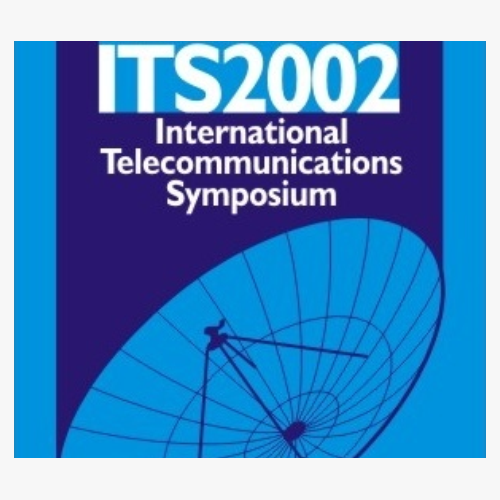
2002 International Telecommunications Symposium
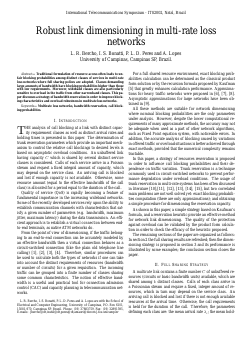
Robust link dimensioning in multi-rate loss networks
L. R. Bercho, I. S. Bonatti, P. L. D. Peres, A. Lopes
DOI: 10.14209/its.2002.716
Keywords: Multirate loss networks bandwidth reservation call blocking probabilities
Abstract
"Traditional formulation of resource access often leads to unfair blocking probabilities among distinct classes of services in multi-rate loss networks where full sharing polices are adopted. Classes demanding large amounts of bandwidth have blocking probabilities higher than those with low requirements. Moreover, wideband classes are also particularly sensitive to overload in the traffic from other narrowband classes. This paper discusses a strategy of bandwidth reservation in order to improve blocking characteristics and overload robustness in multirate loss networks."Download
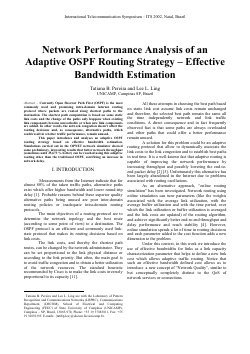
Network Performance Analysis of an Adaptive OSPF Routing Strategy-Effective Bandwidth Estimation
Tatiana B. Pereira, Lee L. Ling
DOI: 10.14209/its.2002.722
Keywords:
Abstract
"Currently Open Shortest Path First (OSPF) is the most commonly used and promising intra-domain internet routing protocol where packets are routed along shortest paths to the destination. The shortest path computation is based on some static link costs and the change of the paths only happens when existing link components become unreachable or when new link components are added. In other words, the network congestion doesn\u2019t affect the routing decisions and, as consequence, alternative paths, which could result in a better traffic performance, remain unused. This paper introduces and analyses an adaptive OSPF routing strategy based on effective bandwidth estimation. Simulations carried out in the OPNET network simulator showed same preliminary, interesting results that better network throughput (sometimes until 25,673 % better) can be reached using this adaptive routing other than the traditional OSPF, sacrificing an increase in network delay."Download

The optical injection locking technique applied to the filtering and remodulation of WDM channel
Aldário C. Bordonalli, Joselan A. Guimarães, Evandro Conforti
DOI: 10.14209/its.2002.728
Keywords: semiconductor lasers optical injection locking optical filters WDM systems
Abstract
"The use of the optical injection locking technique for information processing in WDM systems is experimentally investigated. As the locking bandwidth is controlled by the amount of injected optical power, only the WDM carrier within a given locking range induces the locking of the slave semiconductor laser and is properly transmitted. The other carriers are absorbed inside the laser structure. In addition, by using a feed-forward laser current approach along with the injection process, the remodulation and/or reshaping of the selected channel information can be performed. It was experimentally observed that injection-locked feed-forwarded semiconductor lasers have the potential to be used as optical filters, offering up to 40 dB extinction ratio, and as remodulators, for a 940 Mb/s optical channel."Download
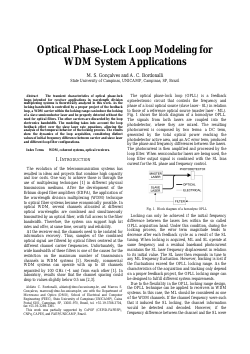
Optical phase-lock loop modeling for WDM system applications
M. S. Gonçalves, A. C. Bordonalli
DOI: 10.14209/its.2002.734
Keywords: WDM coherent systems optical receivers
Abstract
"The transient characteristics of optical phase-lock loops intended for receiver applications in wavelength division multiplexing systems is theoretically analyzed in this work. As the locking bandwidth is controlled by a proper project of the feedback loop, a WDM carrier within the locking range can induce the locking of a slave semiconductor laser and be properly detected without the need for optical filters. The other carriers are discarded by the loop electronics bandwidth. The modeling takes into account the loop feedback effect over the slave laser rate equations, allowing the analysis of the temporal behavior of the locking process. The results show the dynamics of the loop acquisition, considering distinct values of initial frequency difference between carrier and slave laser and different loop filter configurations."Download

Optical Packet Switching: new system for packet generation and highly selective header recognition
F. Rudge Barbosa, A. C. Sachs, R.. S. Ferreira, M. T. Furtado
DOI: 10.14209/its.2002.740
Keywords: Optical networks Photonic switching digital communications
Abstract
"By using a highly selective RF filtering for optical packet header frequency recognition, we have obtained significant improvement in optical switching function. Ultrafast switching (\u00b5s timebase) is realized by using RF frequency tones, inserted in the optical packet that carries a digital payload. The RF header is detected at optical node input, and signals the node switching control, which instantly directs the packet to a prescribed output. The optical circuit is noise-free, has no crosstalk, and is extremely selective in RF frequency header detection. BER measurements for payload consistently yield figures as low as 10 -12 . This system is also fully compatible with DWDM systems."Download
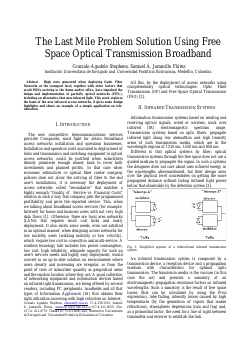
The last mile problem solution using free space optical transmission broadband
Gonzalo Agudelo Stephens, Samuel Á. Jaramillo Flórez
DOI: 10.14209/its.2002.745
Keywords:
Abstract
"High costs generated when deploying Optic Fiber Networks at the transport level, together with other factors that avoid PONs arriving to the home and/or office, have impulsed the design and implementation of partially optical networks (FITL), including an alternative that uses infrared light. This work explores the basis of the new infrared access networks, it gives some design highlights and shows an example of a simple application on tele-education."Download
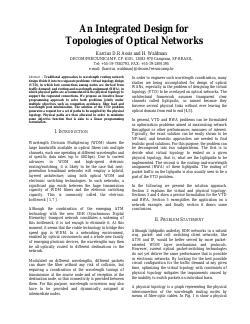
An Integrated Design for Topologies of Optical Networks
Karcius D.R Assis, H. Waldman
DOI: 10.14209/its.2002.751
Keywords:
Abstract
"Traditional approaches to wavelength routing network design divide it into two separate problems: virtual topology design (VTD), in which best connections among nodes are derived from traffic demand; and routing-and-wavelength assignment (RWA), in which physical paths are accommodated in the physical topology to support the requested connections. We propose an iterative linear programming approach to solve both problems jointly under multiple objectives such as congestion avoidance, fiber load and wavelength pool minimization. The solution of the VTD problem generates a request for a set of paths to be supplied by the physical topology. Physical paths are then allocated in order to minimize some objective function that is akin to a linear programming formulation."Download

FWM versus XPM in WDM Systems Using Low Dispersion Fibers
Márcio Freitas, Luiz C. Calmon, Renato Tannure R. Almeida
DOI: 10.14209/its.2002.757
Keywords:
Abstract
"The influence of cross-phase modulation (XPM ) and fourwave mixing (FWM) on the performance of WDM system s using dispersion-shifted fibers (DS) and non-zero dispersion shifted fibers (NZ-DS) are studied and the role of these effects in the penalty for different cases are discussed."Download
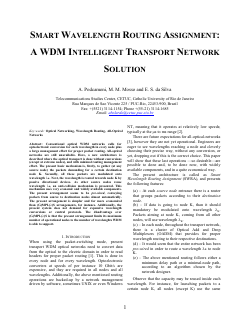
Smart Wavelength Routing Assignment : A WDM Intelligent Transport Network Solution
A. Podcameni, M. M. Mosso, E. S. da Silva
DOI: 10.14209/its.2002.762
Keywords: Optical Networking Wavelength Routing All-Optical Networks
Abstract
"Conventional optical WDM networks calls for optoelectronic conversion for each wavelength in every node plus a large management effort for proper packet routing. All-optical networks are still unavailable. Here, a new architecture is described where the optical transport is done without conversions (except at extreme nodes), and with minimal routing management effort. The present basic mechanism is, firstly, to gather (at any source node) the packets demanding for a certain destination node K. Secondly, all these packets are modulated onto wavelength \u03bbK. Next, the wavelength is routed towards node K by passive directional devices. As other source nodes reuse wavelength \u03bbK, an anti-collision mechanism is presented. This mechanism uses very economic and widely available components. The present arrangement seems to be pre-wired, conveying packets from source to destination nodes almost automatically. The present arrangement is simpler and far more economical than (G)MPL(\u03bb)S arrangements, for instance. Additionally, the present system does not demand for expensive wavelength conversions or central protocols. The disadvantage over (G)MPL(\u03bb)S is that the present arrangement limits its maximum number of operational nodes to the number of wavelenghts WDM is able to support."Download
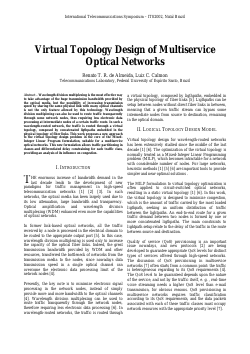
Virtual Topology Design of Multiservice Optical Networks
Renato T. R. de Almeida, Luiz C. Calmon
DOI: 10.14209/its.2002.768
Keywords:
Abstract
"Wavelength division multiplexing is the most effective way to take advantage of the huge transmission bandwidth provided by the optical media, but the possibility of increasing transmission speed by sharing the same physical link with many optical channels is not the only feature allowed by this technology. Wavelength division multiplexing can also be used to route traffic transparently through some network nodes, thus requiring less electronic data processing at intermediate nodes of a certain traffic route. In such a wavelength-routed network, the traffic is routed through a virtual topology, composed by concatenated ligthpaths embedded in the physical topology of fiber links. This work proposes a new approach to the virtual topology design problem in the core of the Mixed-Integer Linear Program formulation, suitable for a multiservice optical networks. This new formulation allows traffic partitioning in classes and differentiated delay constraining for each traffic class, providing an analysis of its influence on congestion."Download